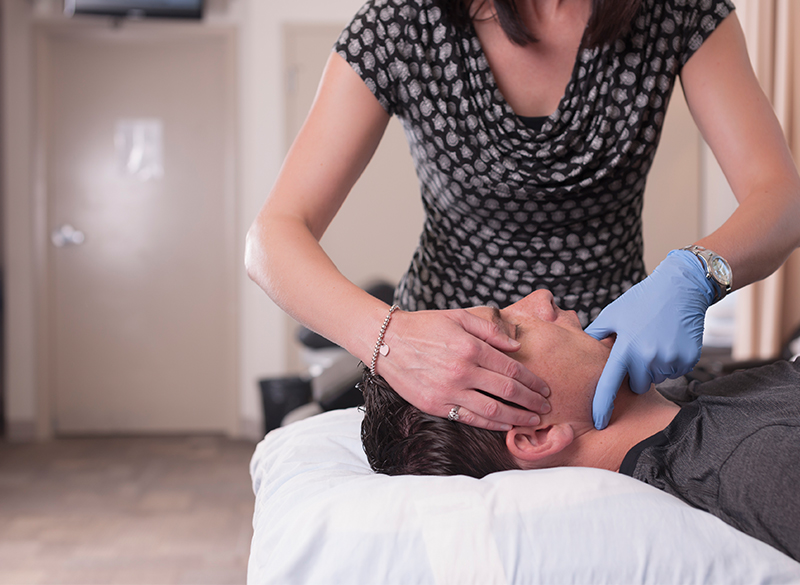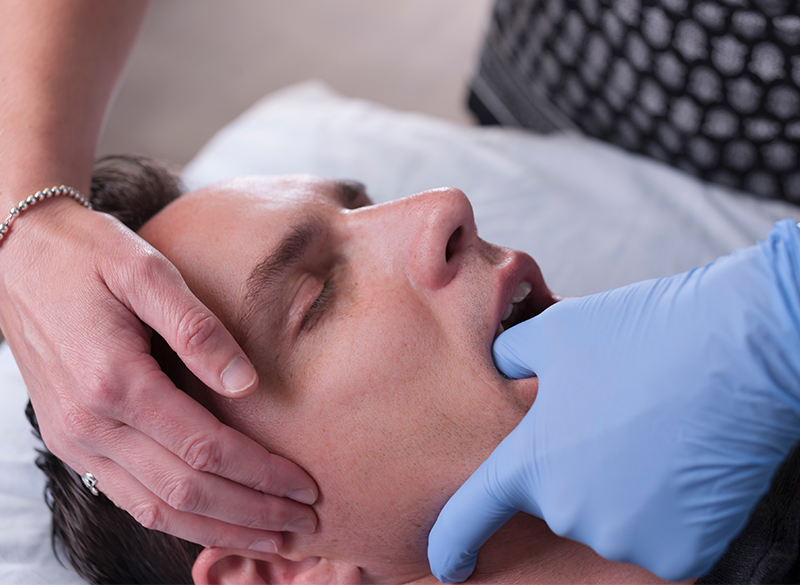
Available at Windermere, St. Albert, and Royal Glenora locations.
we believe that it shouldn’t hurt to eat or open your mouth
Jaw pain in St. Albert or Edmonton? As part of our Physical Therapy Division, we offer to you our TMD & Orofacial Pain Program. Our program is eligible for insurance coverage as physiotherapy when performed by one of our physiotherapists.
Many patients present to the dentist and our physiotherapy clinics with complaints of pain in the area of their temporomandibular joint (TMJ). Temporomandibular disorder (TMD) is a diagnosis that may involve problems with the masticatory (chewing) muscles, TMJ (jaw), and/or associated structures. Major signs and symptoms for TMD are:
- Pain in the masseter (lower jaw bone) muscle, TMJ, and/or temporalis (temple) muscle region
- Mouth-opening limitation or decreased side to side jaw movement
- TMJ sounds (clicking or grinding)
- TMJ locking
TMD symptoms fluctuate and may be aggravated by clenching, grinding, chewing, talking, singing, yawning, poor posture, sleeping position, and/or poor habits such as phone cradling and leaning the chin on the hand. Psychosocial factors such as worry, stress, irritation, frustration, and depression may also negatively impact TMD symptoms. Other symptoms affecting the head and neck region such as headache, ear/hearing related symptoms and neck disorders may also be associated with TMD.
our approach:
Our initial evaluation will involve a thorough history and physical examination by one of our specially trained physiotherapists. The assessment includes examination of posture, the cervical spine and the TMJ to establish a primary diagnosis. We will identify contributing factors, at fault structures and establish a treatment plan in conjunction with your dentist or another TMJ specialist if necessary.
why choose Leading Edge TMD treatment?
Leading Edge TMD treatments envelope the spectrum of available techniques and modalities found in today’s research. These are directed towards decreasing muscle tightness, reducing inflammation, improving range of motion, and decreasing pain. Treatment techniques utilized by our specially trained physiotherapist(s) may include: modalities such as heat, ice, transcutaneous electrical nerve stimulation (TNS), ultrasound, LLLT (Cold Laser) and Iontophoresis. We utilize a hands on approach when indicated that also includes specially trained techniques in myofascial release, joint mobilization, Graston Technique, acupuncture and intramuscular stimulation.
Exercises are essential, but must be prescribed depending upon the specific diagnosis. These often include: neck stretches, postural retraining, TMJ stretching, muscle relaxation techniques, controlled opening exercises of the TMJ, Rocabado and rhythmic stabilization exercises.
Your temporomandibular joint (TMJ) is a hinge that connects your mandible (jaw) to the temporal bones of your skull, found just in front of each ear. The function of this hinge joint lets a person move their jaw up and down and side to side, so one can talk, chew, yawn and even whistle.
Problems with the jaw and the facial muscles that control it are known as temporomandibular disorders (TMD). The term when properly applied is TMD and not TMJ, as this simply describes the joint. When a person has a pain or problem with the jaw we therefore call it TMD.
There are no comprehensive explanations that account for all of the causes of TMD. In many cases the onset of pain comes on slowly and without a direct or obvious injury. In these cases, symptoms likely arise from problems with the muscles of the jaw or with the parts of the joint itself.
Injury to the jaw, the joint, or the muscles of your head and neck like from a heavy blow or whiplash may lead to TMD.
Other causes may include:
- Grinding or clenching of the teeth. This increases the pressure on the joint and leads to overuse and fatigue of the facial muscles
- Movement of or dislocation of the disc (a soft cushion) between the ball and socket of the joint
- Wear and tear in the joint in the form of arthritis
- Stress, which can cause you to tighten facial and jaw muscles or clench the teeth
- Stress on the the TMJ following a long dental procedure with your mouth open
In short, if you have pain in the jaw or difficulty eating, chewing or yawning, then the  sooner you attend an assessment the better.
sooner you attend an assessment the better.
Symptoms may come on suddenly or slowly over time. It may cause severe pain and /or mild discomfort. It can be temporary or last many years. It might affect one or both sides of your face. It can cause headaches and even dizziness.
If you suffer from the following symptoms, then a TMJ treatment may be in order:
- Pain or tenderness in or around the ear when you chew, speak, or open your mouth wide
- Pain or tenderness in your face, below the ears, the jaw joint area, neck and/or shoulders
- Jaws that get “locked” in the open- or closed-mouth position
- Clicking, popping, grinding or grating sounds in the jaw joint when you open or close your mouth, yawn, chew or smile
- A tired feeling in your face
- Trouble chewing or a sudden uncomfortable bite — as if the upper and lower teeth are not fitting together properly
- Swelling or bruising on the side of your face
Other signs and symptoms include toothaches, headaches, neck aches, dizziness, earaches, hearing problems, upper shoulder pain, and ringing in the ears (tinnitus).
If you have any of the above signs and or symptoms, our therapists are available to assess and treat your possible TMD.
When a patient attends for an assessment of their condition our physiotherapist will assess and qualify them if they have:
- Pain in the area of the masticatory muscles or TMJ
- Muscle stiffness within the masticatory system
- TMJ catching or locking
- Frequent headaches
- Malocclusion
- Limited mandibular range of motion:
- Less than 40mm opening, including overlap of teeth
- Less than 7mm right or left lateral excursion
- Less than 6mm of protrusion
Patients can also be assessed post-surgically and treated appropriately within the limitations of the available protocol and/or post-surgical expectations. Types of surgery include arthrocentesis, arthroscopy, arthroplasty with discectomy, and total joint replacement
Kristen Fitzgerald and Lindsay James have undergone the TMD and Orofacial Pain Miniresidency at the University of Minnesota School of Dentistry. As the TMD and Orofacial Pain clinic at the University of Minnesota utilizes a multi-disciplinary approach they are also versed in the various treatments available from all disciplines and can assist you with making appropriate referrals as necessary.
Jonathan Tong and Tayler Gray have undergone extensive orthopedic training and testing having achieved their Part-B designations as a fellows of the Canadian Academy of Manipulative Phsyical Therapists. They have worked with TMD patients for more than 15 years each and have vast experience in the rehabilitation of complex muskuloskeletal pain.





